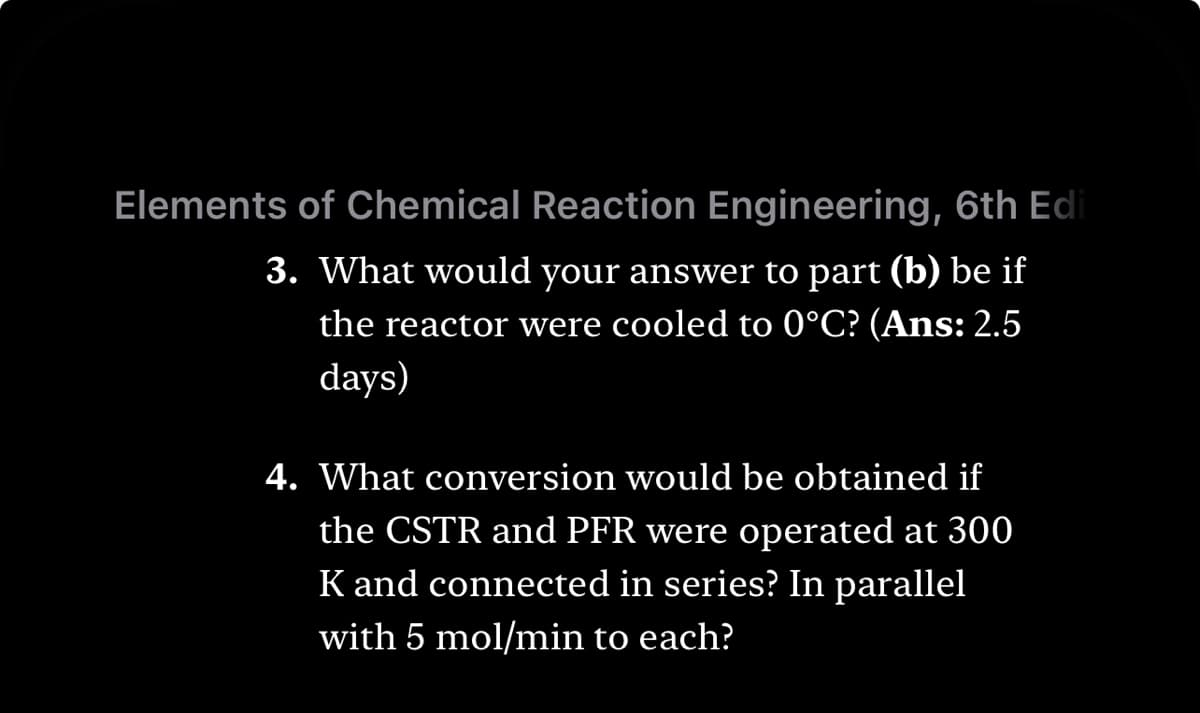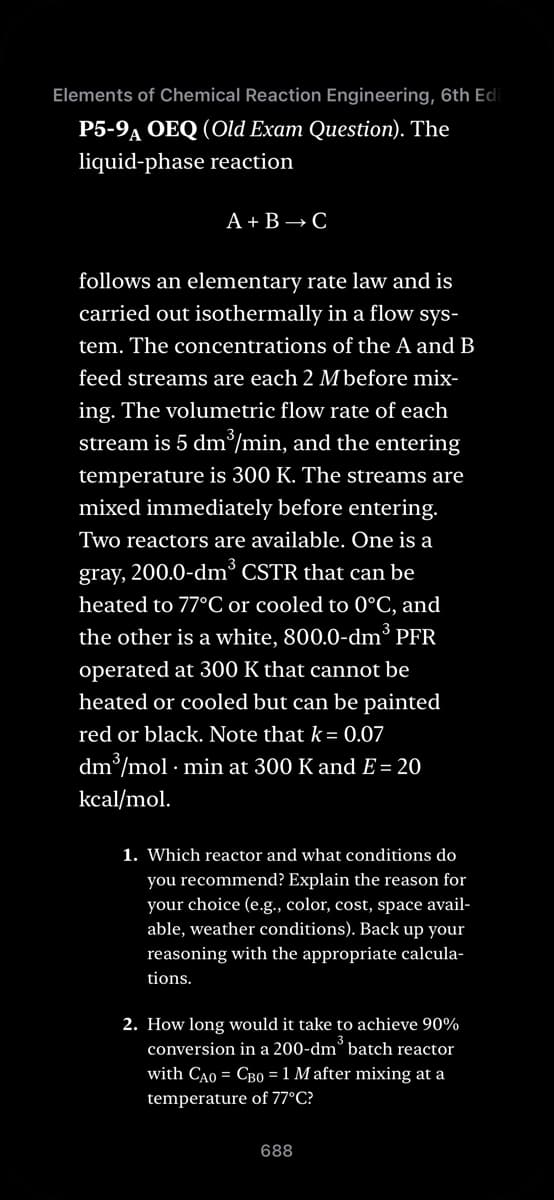Elements of Chemical Reaction Engineering, 6th Edi P5-9A OEQ (Old Exam Question). The liquid-phase reaction A + B → C follows an elementary rate law and is carried out isothermally in a flow sys- tem. The concentrations of the A and B feed streams are each 2 M before mix- ing. The volumetric flow rate of each stream is 5 dm³/min, and the entering temperature is 300 K. The streams are mixed immediately before entering. Two reactors are available. One is a gray, 200.0-dm³ CSTR that can be heated to 77°C or cooled to 0°C, and the other is a white, 800.0-dm³ PFR operated at 300 K that cannot be heated or cooled but can be painted red or black. Note that k = 0.07 dm³/mol · min at 300 K and E = 20 kcal/mol. 1. Which reactor and what conditions do you recommend? Explain the reason for your choice (e.g., color, cost, space avail- able, weather conditions). Back up your reasoning with the appropriate calcula- tions. 2. How long would it take to achieve 90% conversion in a 200-dm³ batch reactor with CAO = CB0 = 1 M after mixing at a temperature of 77°C?
Elements of Chemical Reaction Engineering, 6th Edi P5-9A OEQ (Old Exam Question). The liquid-phase reaction A + B → C follows an elementary rate law and is carried out isothermally in a flow sys- tem. The concentrations of the A and B feed streams are each 2 M before mix- ing. The volumetric flow rate of each stream is 5 dm³/min, and the entering temperature is 300 K. The streams are mixed immediately before entering. Two reactors are available. One is a gray, 200.0-dm³ CSTR that can be heated to 77°C or cooled to 0°C, and the other is a white, 800.0-dm³ PFR operated at 300 K that cannot be heated or cooled but can be painted red or black. Note that k = 0.07 dm³/mol · min at 300 K and E = 20 kcal/mol. 1. Which reactor and what conditions do you recommend? Explain the reason for your choice (e.g., color, cost, space avail- able, weather conditions). Back up your reasoning with the appropriate calcula- tions. 2. How long would it take to achieve 90% conversion in a 200-dm³ batch reactor with CAO = CB0 = 1 M after mixing at a temperature of 77°C?
Introduction to Chemical Engineering Thermodynamics
8th Edition
ISBN:9781259696527
Author:J.M. Smith Termodinamica en ingenieria quimica, Hendrick C Van Ness, Michael Abbott, Mark Swihart
Publisher:J.M. Smith Termodinamica en ingenieria quimica, Hendrick C Van Ness, Michael Abbott, Mark Swihart
Chapter1: Introduction
Section: Chapter Questions
Problem 1.1P
Related questions
Question
Answer 1-4

Transcribed Image Text:Elements of Chemical Reaction Engineering, 6th Edi
3. What would your answer to part (b) be if
the reactor were cooled to 0°C? (Ans: 2.5
days)
4. What conversion would be obtained if
the CSTR and PFR were operated at 300
K and connected in series? In parallel
with 5 mol/min to each?

Transcribed Image Text:Elements of Chemical Reaction Engineering, 6th Edi
P5-9A OEQ (Old Exam Question). The
liquid-phase reaction
A + B → C
follows an elementary rate law and is
carried out isothermally in a flow sys-
tem. The concentrations of the A and B
feed streams are each 2 M before mix-
ing. The volumetric flow rate of each
stream is 5 dm³/min, and the entering
temperature is 300 K. The streams are
mixed immediately before entering.
Two reactors are available. One is a
gray, 200.0-dm³ CSTR that can be
heated to 77°C or cooled to 0°C, and
the other is a white, 800.0-dm³ PFR
operated at 300 K that cannot be
heated or cooled but can be painted
red or black. Note that k = 0.07
dm³/mol. min at 300 K and E = 20
kcal/mol.
1. Which reactor and what conditions do
you recommend? Explain the reason for
your choice (e.g., color, cost, space avail-
able, weather conditions). Back up your
reasoning with the appropriate calcula-
tions.
2. How long would it take to achieve 90%
conversion in a 200-dm³ batch reactor
with CAO = CB0 = 1 M after mixing at a
temperature of 77°C?
688
Expert Solution
This question has been solved!
Explore an expertly crafted, step-by-step solution for a thorough understanding of key concepts.
Step by step
Solved in 5 steps with 4 images

Recommended textbooks for you

Introduction to Chemical Engineering Thermodynami…
Chemical Engineering
ISBN:
9781259696527
Author:
J.M. Smith Termodinamica en ingenieria quimica, Hendrick C Van Ness, Michael Abbott, Mark Swihart
Publisher:
McGraw-Hill Education

Elementary Principles of Chemical Processes, Bind…
Chemical Engineering
ISBN:
9781118431221
Author:
Richard M. Felder, Ronald W. Rousseau, Lisa G. Bullard
Publisher:
WILEY

Elements of Chemical Reaction Engineering (5th Ed…
Chemical Engineering
ISBN:
9780133887518
Author:
H. Scott Fogler
Publisher:
Prentice Hall

Introduction to Chemical Engineering Thermodynami…
Chemical Engineering
ISBN:
9781259696527
Author:
J.M. Smith Termodinamica en ingenieria quimica, Hendrick C Van Ness, Michael Abbott, Mark Swihart
Publisher:
McGraw-Hill Education

Elementary Principles of Chemical Processes, Bind…
Chemical Engineering
ISBN:
9781118431221
Author:
Richard M. Felder, Ronald W. Rousseau, Lisa G. Bullard
Publisher:
WILEY

Elements of Chemical Reaction Engineering (5th Ed…
Chemical Engineering
ISBN:
9780133887518
Author:
H. Scott Fogler
Publisher:
Prentice Hall


Industrial Plastics: Theory and Applications
Chemical Engineering
ISBN:
9781285061238
Author:
Lokensgard, Erik
Publisher:
Delmar Cengage Learning

Unit Operations of Chemical Engineering
Chemical Engineering
ISBN:
9780072848236
Author:
Warren McCabe, Julian C. Smith, Peter Harriott
Publisher:
McGraw-Hill Companies, The